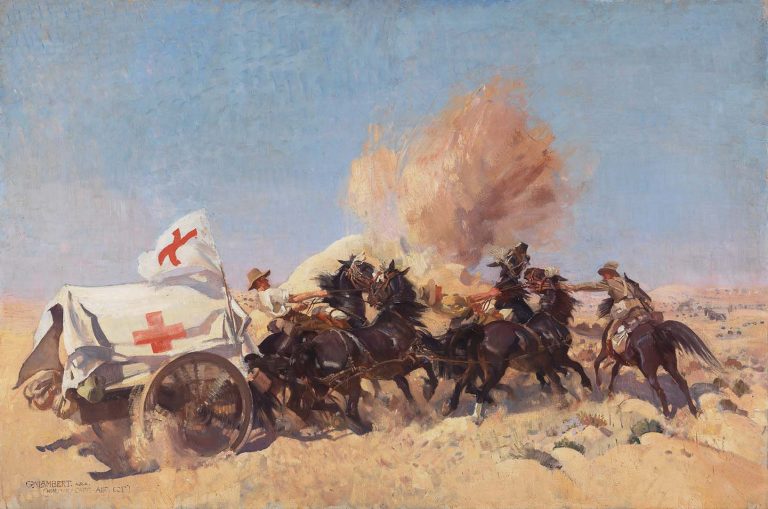We acknowledge the Traditional Owners of the land on which the Queensland Art Gallery | Gallery of Modern Art stands and recognise the creative contribution First Australians make to the art and culture of this country.

George W. Lambert / Australia/England 1873–1930 / Walk (An incident at Romani) 1919–22 / Oil on canvas / 92 x 138.1cm / Gift of the 2nd Light Horse Field Ambulance in memory of Comrades who did not return from the war c.1922 / Collection: Queensland Art Gallery | Gallery of Modern Art
George W. LambertWalk (An incident at Romani) 1919–1922
Not Currently on Display
During World War One, George Lambert served Australia as an Official War Artist attached to the ANZAC Mounted Division. As a result of this service Lambert was offered a variety of commissions to paint scenes from significant wartime events after his war contract had officially ended in 1920. Among these was a commission from the 2nd Light Horse Field Ambulance (the corps was formed in Brisbane with a contingent from Gympie) to paint an action of the Field Ambulance during the Turkish attack at Romani, in the north-west Sinai Desert.
The incident to which the painting refers occurred during the Battle of Romani on 4 August 1916. The 2nd Light Horse Field Ambulance had deployed two sand carts to an exposed part of the line in order to retrieve seriously wounded men. Upon its return journey, the Field Ambulance envoy came under Turkish fire and its panicked horses started to bolt.
Tragedy was averted when the corporal signalled ‘walk’, and galloped to the front of the party to steady the teams. After the horses had been calmed and resumed their pace, the enemy apparently recognised the Ambulance’s mission and averted their fire. As a result of their bravery and composure during the incident the corporal and drivers were awarded service medals. The completed painting was given to the Queensland Art Gallery by the 2nd Light Horse Field Ambulance in memory of their fallen comrades.
George Washington Thomas Lambert was born in 1873 in St Petersburg, Russia. The family moved to England in 1881, where Lambert went to school, before they finally immigrated to New South Wales in 1887.
In 1899 Lambert won the Wynne Prize for landscape with one of his most important paintings, Across the black soil plains (Art Gallery of New South Wales). Soon afterwards he left Australia for Europe with his wife, enrolling at Académie Colarossi in Paris along with fellow Australian artist Hugh Ramsay. As a specialist in portraiture Lambert was able to make an income through commissions from subjects as important as King Edward VII; however, many of his portraits were uncommissioned paintings and sketches of his own family and friends.
During World War One he became a very successful and prolific war artist with the Australian Light Horse Brigade in Palestine from 1917 until 1920. In 1922 he was elected an associate of the Royal Academy in London. Released from his duties as a war artist, Lambert once again specialised in portraiture. He continued to exhibit with the Society of Artists, and from 1926 with the Contemporary Group, which he formed with Thea Proctor.
Discussion Questions
1. What comes to mind immediately when you view this painting and how does the story behind the work affect your response?
2. What strategies are employed to convey the drama and emotion of this scene? Consider how this painting would be different to the viewing of a documentary photograph taken of the same scene.
3. The term ‘official war artist’ is used to describe artists who are employed to produce specific works of art which depict conflict. Why do we still employ artists as well as photographers to document wars?
Activities
1. Imagine you are one of the characters in the painting and write a letter or journal entry to describe your experience.
2. In groups, re-construct your version of Walk (An incident at Romani). Consider the main elements that make up the subject matter of this image: horses, soldiers, Red Cross, desert, sky, smoke, wheel/wagon, the title. In small groups, each select one of these elements to work with. On an A3 sheet of paper, draw your piece of the subject matter. Display the multi-panelled work alongside a reproduction of Lambert’s original. Discuss the comparative results.